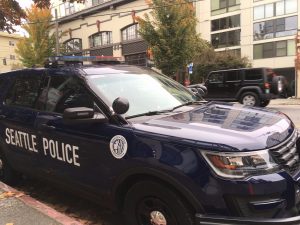The Central District, known to locals as the CD, is one of Seattle’s most historically diverse areas. It began as a Jewish neighborhood at the turn of the 20th century, but by the mid 1930s a large Japanese population had begun to call the CD home until executive order 9066 saw that community interned in camps during WWII. The overnight expulsion of the Japanese residents left space open for a growing Black populace to settle; barred by racially-motivated lending and rental policies from many other parts of the city, the community entrenched itself and flourished.
In 1935, the Home Owners’ Loan Corporation began to draw thick red lines around neighborhoods it deemed too poor or “at risk” to receive financial assistance such as loans or mortgages. The effect of this red-lining on the Central District created an impermeable economic and social barrier. People could not leave the CD and basic needs such as adequate healthcare and affordable food could not be obtained.
What long-term CD residents will tell you is that the obvious discrimination and racist policies helped forge an indelible and strong community inside this red-lined neighborhood. Being so deeply disenfranchised by the City and a white power structure left people to develop a self-sufficient local economy, eventually birthing a thriving network of Black owned businesses, community centers, churches and schools.
The effect of this red-lining on the Central District created an impermeable economic and social barrier.
Economic shifts starting in the 1980s began a slow but devastating process we know as gentrification. Black communities all over the country came under attack from the introduction of crack cocaine into neighborhoods with large radical social movements thanks to the misguided “war on drugs” that began to incarcerate a disproportionate amount of Black men. Property in the CD began to flip into the hands of developers and members of Seattle’s upper middle class white population as they got priced out of the Mt. Baker, Leschi and Madison Valley neighborhoods.
By the early 2010’s the CD had already seen a massive amount of displacement, as the Black population fell to nearly 23% from it’s previous level close to 75% in the 1970’s. The influx of luxury development has shaped a new CD of angular townhomes and newly remodeled single family dwellings, but has lost most of its long-term and foundational elements of community.
Elements of this community can still be seen, but primarily in its response to attacks from developers, the police or a benevolent city government. This was exemplified in the large town hall style meeting held after a memo sent from the Seattle Police Department’s chief strategy officer, Christopher Fischer, in the wake of a series of shootings in the CD earlier this year. The memo gave 4 points on how SPD was going to be handling the theoretical up-tick in shootings in the CD, focusing heavily on bringing in active SWAT and K-9 “for increased visibility and for faster response should an incident occur.” According to the memo, SPD would be utilizing overtime to “increase anti-violence emphasis patrols…using data to ensure they are deployed where and when the violence is likely to occur”, units that would stand at the ready to respond quickly to calls.
‘…an increased police presence might make some people feel safer, but it actually jeopardizes the safety of people of color…’
At the community forum held in the historic Washington Hall, among chairs scraping and the din of conversation, one element was discernible: the idea that more police flooding into the CD was not a guarantee of improved safety. According to a Facebook response from Black Lives Matter Seattle-King County, “…an increased police presence might make some people feel safer, but it actually jeopardizes the safety of people of color…” The correlation between targeted police responses and the increased incarceration rates of people of color are not lost on these long-term activists.
According to the same memo, there has been an increase in “calls from the community” by 2.5% over the same period from 2017. In that same time, major property crime was down 4%, and lesser property crimes (burglary, larceny, theft and car prowls) were down 49%. But Officer Initiated Actions, which consist mostly of perimeter checks, suspicious circumstances, and traffic enforcement, are up 39.8% according to SPD’s numbers.
Calls from the community are often cited by SPD as a reason to increase patrols or the number of police units to a certain neighborhood or parts of a certain neighborhood. The strategy known as “targeted policing” has gotten mixed reviews from community groups and Law Enforcement agencies. The numbers that SPD has released show little to no correlation between increased gun violence, community calls to the department and the actions of officers on the ground.
The correlation between targeted police responses and the increased incarceration rates of people of color are not lost on these long-term activists.
This seemingly unrelated policing structure has left many concerned that the increase of police units, waiting and at the ready to race into the Central District, might have more to do with the shifting economic and racial demographics than a true want to keep the residents safe. A once segregated community, now facing a rising tide of property tax and gentrification, can only be left to wonder what comes next as the cranes continue to dot the skyline down 23rd Ave.






